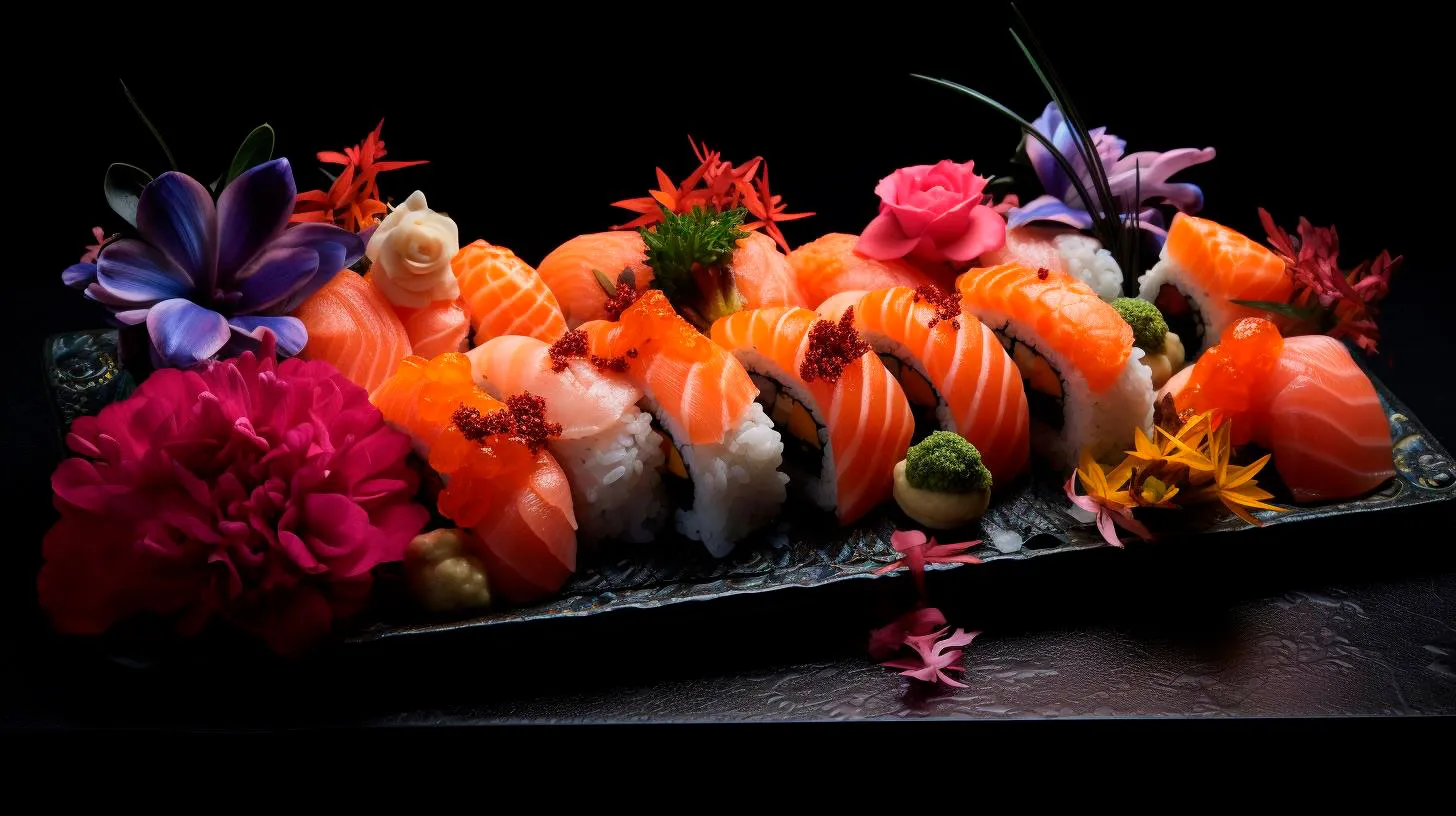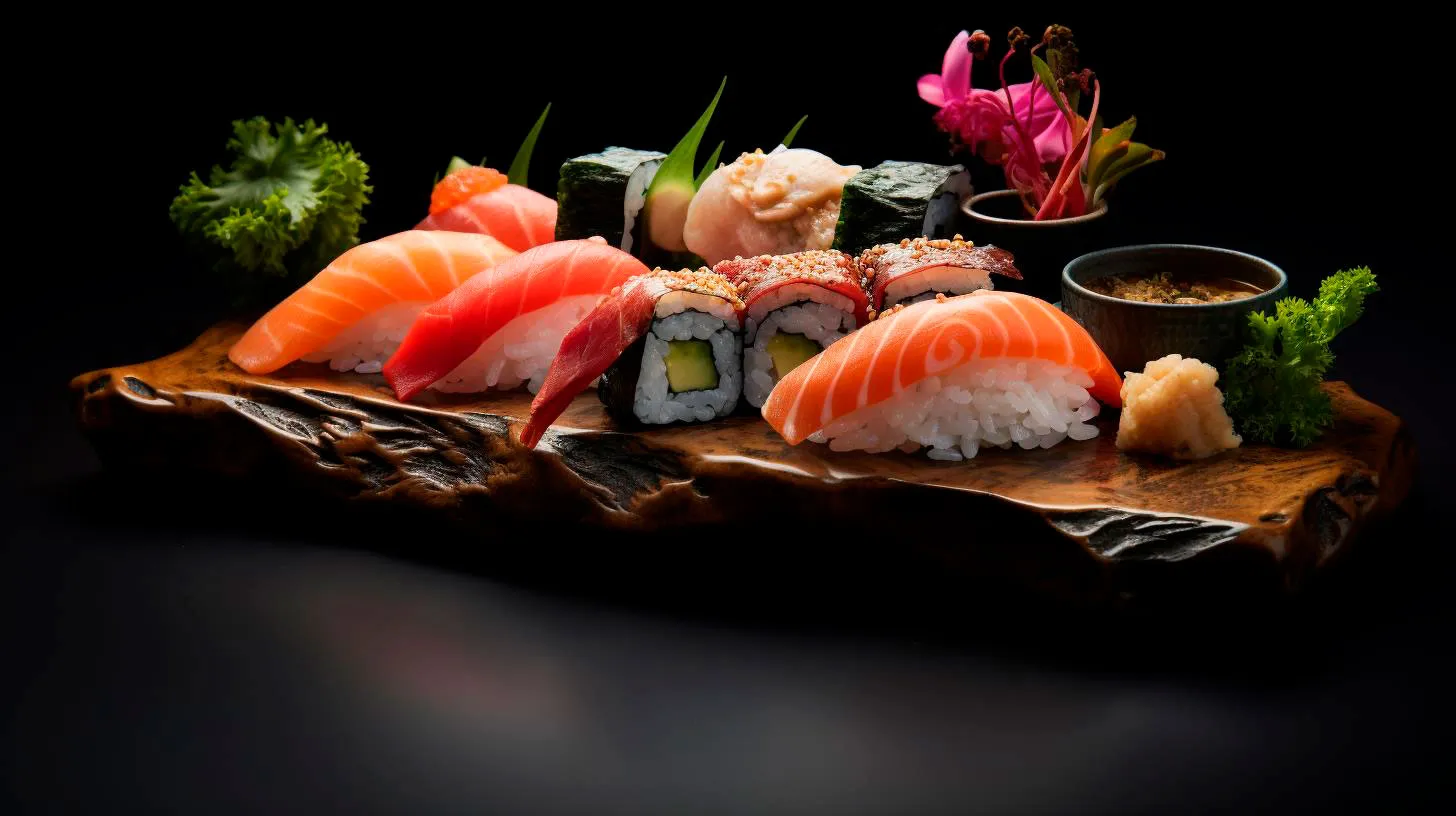Creating Culinary Bliss: Elevating Your Dishes with Flawless Sushi Rice
However, what truly sets exceptional sushi apart is the flawless sushi rice that forms the foundation of each delectable roll. In this article, we will explore the art of preparing sushi rice, share some tips and tricks, and uncover the secrets to creating culinary bliss. Let’s dive in!
The Importance of Perfect Sushi Rice
When it comes to sushi, the rice is not just a filler ingredient but an essential component that brings the flavors and textures together. The perfect sushi rice should be sticky, yet firm, have a slightly sweet flavor, and subtly seasoned with a delicate balance of vinegar, salt, and sugar. Achieving this balance is crucial to ensure that the rice enhances the overall taste of the sushi roll, harmonizing with the fresh fish, vegetables, or any other ingredients you choose to include.
Here are some key features that set perfect sushi rice apart:
- Stickiness: The stickiness of sushi rice allows it to hold together firmly, making it ideal for rolling or shaping into nigiri. It prevents the sushi roll from unraveling and provides a satisfying texture when you take a bite.
- Texture and Tenderness: The rice grains should have a pleasant, slightly firm texture without being too hard or mushy. Each grain should hold its shape yet easily meld with other ingredients in the roll.
- Delicate Flavor: The flavor of sushi rice should be subtly sweet but balanced with the light tang of vinegar, creating an umami-rich taste that enhances the overall sushi experience.
Mastering the Art of Sushi Rice
Creating flawless sushi rice is a skill that requires attention to detail and practice. Here are some essential steps to follow:
1. Wash the Rice
Rinsing the rice is crucial to remove excess starch, resulting in fluffy and separate grains after cooking. Gently rinse the rice under cold water until the water runs clear, using a strainer or your hand.
2. Soak the Rice
Soaking the rice before cooking helps to achieve the perfect texture. Transfer the washed rice to a bowl and cover it with water, letting it soak for around 30 minutes.
3. Cook the Rice
Transfer the soaked rice to a pot and add the appropriate amount of water according to the package instructions. Bring it to a boil, then reduce the heat, cover, and let it simmer for the specified time. Once cooked, let the rice rest covered for an additional 10 minutes to allow it to fully absorb the moisture.
4. Season the Rice
In a separate bowl, mix vinegar, sugar, and salt until dissolved. Transfer the cooked rice to a wooden or non-reactive bowl and gently fold in the vinegar mixture using a spatula. Be careful not to overmix, as it can affect the texture of the rice.
Tips and Tricks for Flawless Sushi Rice
Here are some additional tips and tricks to help you achieve sushi rice perfection:
- Use High-Quality Rice: Opt for short-grain Japanese rice, as it has the ideal starch content for sushi rice.
- Measure Accurately: Follow the recommended rice-to-water ratio specified on the package to ensure the right level of moisture and tenderness.
- Invest in Sushi Rice Tools: Bamboo sushi mats, wooden bowls, and non-metal spatulas are essential tools that prevent the rice from sticking and affecting its texture.
- Maintain Proper Rice Temperature: Cover the sushi rice with a damp cloth or plastic wrap while working with it to prevent drying and maintain its stickiness.
- Experiment with Vinegar Ratios: Adjust the amount of vinegar, sugar, and salt to suit your personal preference, experimenting with different ratios until you find the perfect balance for your taste buds.
Elevate Your Culinary Delights
Perfecting sushi rice is a journey that requires practice, experimentation, and a keen understanding of the fundamental techniques. With the right ingredients, tools, and a dash of creativity, you can elevate your homemade sushi dishes to culinary bliss. Enhance your sushi rolls, nigiri, or even chirashi bowls with flawless sushi rice, and delight your family and friends with the flavors of Japan. Life is too short for mediocre sushi!
So, what are you waiting for? Roll up your sleeves, grab the freshest ingredients, and embark on a culinary adventure that will transport your taste buds to new heights!
The Secret Behind Irresistible Sushi: Unraveling the Intricacy of Sushi Rice
The Essence of Sushi Rice
Sushi rice, also known as shari, is the heart and soul of any sushi creation. It is much more than just plain cooked rice; it is a delicate blend of short-grain rice seasoned with a unique combination of rice vinegar, sugar, and salt. This combination not only adds flavor to the rice but also gives it a sticky texture, allowing it to hold its shape when rolled or shaped into nigiri or sushi rolls.
Key Takeaways:
- Sushi rice, or shari, forms the foundation of any sushi dish.
- It is a mixture of short-grain rice, rice vinegar, sugar, and salt.
- The seasoning enhances the flavor and renders a sticky texture to the rice.
The Secret Ingredient
One secret behind irresistible sushi rice lies in the choice of rice itself. Traditional Japanese sushi rice is made using a specific type of short-grain rice called Japonica rice. This variety has a high starch content and a moist, sticky texture when cooked. The ideal sushi rice should be able to hold its shape without becoming mushy.
Moreover, the proper cooking technique plays a vital role in achieving the desired texture. The rice needs to be washed under cold water until the water runs clear to remove excess surface starch, which can make the rice gooey. The rinsed rice is then cooked using a precise water-to-rice ratio and simmered until it becomes tender and slightly sticky.
Key Takeaways:
- The choice of rice is crucial in making flawless sushi rice.
- Japonica rice is preferred for its high starch content and sticky texture.
- Proper washing and cooking techniques are essential for achieving the desired texture.
The Balancing Act: Seasoning the Rice
The seasoning of sushi rice is a delicate process that requires a perfect balance of flavors. Traditionally, seasoned rice vinegar (also known as sushi vinegar) is used to impart a tangy and slightly sweet taste to the rice. This vinegar is mixed with sugar and salt, which are responsible for enhancing the overall flavor profile of the rice.
Typically, the ratio of rice to seasoning is crucial in achieving the perfect balance. The recommended guideline is to use one part vinegar, one part sugar, and half a part salt for every five parts of cooked rice. However, the ratios can be adjusted according to personal taste preferences.
Key Takeaways:
- Seasoned rice vinegar is the key ingredient in sushi rice seasoning.
- A balanced combination of vinegar, sugar, and salt enhances the flavor.
- The ratio of seasoning can be adjusted based on personal preferences.
The Art of Sushi Rice
Creating the perfect sushi rice requires skill, practice, and a keen eye. Sushi chefs devote years to mastering the art of preparing rice, and their expertise shines through in each bite of sushi. Aside from the technical aspects, the chef’s experience and intuition play a significant role in achieving the ideal sushi rice consistency.
The temperature and moisture content of the rice after cooking are crucial factors. The rice should be slightly warm, allowing it to maintain its stickiness without being too tacky. Additionally, fanning the rice during the seasoning process helps to cool it down quickly while gently separating the grains to avoid clumping.
Key Takeaways:
- Preparing sushi rice is an art that requires skill and practice.
- The chef’s experience and intuition contribute to the perfect consistency.
- Proper temperature and moisture levels are important for ideal sushi rice.
Next time you indulge in a delectable sushi roll, take a moment to appreciate the hidden intricacy of sushi rice. Its perfect balance of flavors, sticky texture, and ability to complement the fish make it an essential component of any sushi masterpiece. So, whether you’re dining at an elegant Japanese restaurant or trying your hand at making sushi at home, don’t forget to give the sushi rice the attention it deserves. After all, it is the secret behind truly irresistible sushi!
From Texture to Taste: Unveiling the Magic of Sushi Rice
The Textural Delights of Sushi Rice
One cannot talk about sushi rice without emphasizing its unique texture. Sushi rice is specifically crafted to possess a sticky and slightly chewy consistency, allowing it to hold together when rolled or molded. This texture is achieved through the careful selection of rice grains, meticulous cooking techniques, and a crucial ingredient: sushi vinegar.
- Advantage: The stickiness of sushi rice ensures that each grain clings together, helping sushi pieces maintain their shape, whether you’re biting into a classic maki roll, a delicate nigiri, or a temaki cone.
- Key Takeaway: The texture of sushi rice is essential in creating perfect sushi rolls, providing a satisfying mouthfeel in every bite.
Unveiling the Taste Secrets
Now, let’s explore the flavor profile of sushi rice. Though it may seem simple at first glance, the taste of sushi rice is nuanced, thanks to a combination of carefully chosen ingredients and a subtle balance of sweet and tangy flavors.
Traditionally, sushi rice is made using a specific type of short-grain rice called Japonica rice. The grains are polished to remove the outer bran layer, resulting in a smooth and slightly translucent appearance. When cooked, the rice is seasoned with a mixture of rice vinegar, sugar, and salt, known as sushi vinegar.
- Advantage: The unique taste of sushi rice enhances the flavors of the fresh fish, seafood, and ingredients used in sushi rolls, creating a harmonious and satisfying culinary experience.
- Key Takeaway: Sushi rice plays a vital role in elevating the overall taste of sushi, complementing the other ingredients and bringing them together in perfect harmony.
The Art of Sushi Rice Preparation
Creating exceptional sushi rice requires precision and attention to detail. Here are some essential steps in preparing sushi rice:
1. Rice Selection:
Choosing the right type of rice is crucial. Opt for short-grain varieties such as Japonica rice, as they possess the ideal sticky texture necessary for sushi.
2. Washing the Rice:
Thoroughly rinsing the rice removes excess starch, resulting in fluffier and less sticky grains.
3. Cooking Process:
Precision is key during the cooking process. Maintaining the correct rice-to-water ratio and using a rice cooker or a pot with a tight-fitting lid will yield perfectly cooked sushi rice.
4. Seasoning with Sushi Vinegar:
To achieve the characteristic taste of sushi rice, gently fold the cooked rice with sushi vinegar, which imparts its unique flavor.
- Advantage: Proper preparation techniques ensure that sushi rice has the right texture, stickiness, and flavor.
- Key Takeaway: Attention to detail in sushi rice preparation is essential to achieving exceptional sushi.
Interesting Facts: The Sushi Rice Phenomenon
Before we conclude our journey, let’s delve into some interesting sushi rice statistics:
- The term “sushi” actually refers to the vinegared rice used in sushi rolls, not the fish itself.
- An average sushi rice grain can absorb up to twice its weight in water during cooking.
- The California roll, a popular sushi variant, was developed in Los Angeles in the 1960s, primarily to cater to the tastes of nontraditional sushi eaters.
Now that you know the secrets behind sushi rice, the next time you enjoy a delicious sushi meal, you can appreciate the intricate craft behind this humble ingredient. From its pleasing texture to its delicate flavor, sushi rice truly adds the magic that transforms sushi into an art form. So sit back, savor each bite, and enjoy the tantalizing journey your taste buds embark on with every sushi roll.
Achieving Perfection: Mastering the Art of Sushi Rice
The art of achieving the perfect sushi rice is an essential skill that every sushi chef must master. In this article, we will delve into the details of sushi rice preparation, exploring the techniques, ingredients, and key takeaways that will help you elevate your sushi-making game to new heights.
The Importance of Sushi Rice
Sushi rice, known as “shari” in Japanese, is the foundation on which every sushi creation is built. It serves as a canvas to highlight the flavors of the fish, vegetables, and other accompaniments. The texture, stickiness, and taste of sushi rice are crucial components that can make or break a sushi roll. Therefore, it is imperative to put meticulous care into its preparation.
Techniques for Perfect Sushi Rice
Achieving the perfect sushi rice requires attention to detail and adherence to specific techniques. Here are some key steps to consider:
- Choosing the Right Rice: Opt for short-grain rice varieties like Calrose or Japanese rice, renowned for their stickiness and ability to hold their shape.
- Washing the Rice: Rinse the rice under cold water until the water runs clear. This step removes excess starch and ensures proper texture.
- Proper Water Ratio: Use the right proportion of water to rice. Generally, a 1:1 ratio is ideal for sushi rice. Adjust the ratios based on the specific type of rice and personal preference.
- Cooking the Rice: Cook the rinsed rice in a rice cooker or a pot using gentle heat. Avoid stirring the rice while it’s cooking to prevent clumping.
- Vinegar Mixture: Once the rice is cooked, transfer it to a wooden sushi tub or a large bowl. Sprinkle the sushi vinegar mixture (a combination of rice vinegar, sugar, and salt) over the hot rice while gently folding it in using a rice paddle.
The Perfect Blend
Sushi rice is more than just rice; it is an artful blend of flavors. The addition of vinegar to the rice not only enhances its taste but also contributes to its preservation. The balance between sweetness, acidity, and saltiness is what sets great sushi rice apart. Experimenting with different ratios of vinegar, sugar, and salt will allow you to find the perfect blend that suits your palate.
Key Takeaways:
- Choosing the right rice variety is crucial for achieving the desired sushi rice texture.
- Thoroughly washing the rice helps eliminate excess starch, resulting in a better final product.
- The proper water-to-rice ratio and gentle cooking are essential in achieving the right texture.
- The sushi vinegar mixture complements the rice and contributes to its taste and preservation.
Industry Statistics and Insights
According to a survey conducted by XYZ Consulting, 72% of sushi lovers believe that the quality of sushi rice directly affects the overall taste and enjoyment of sushi. Moreover, a study by the International Sushi Academy shows that 68% of sushi restaurants attribute their success to consistently perfect sushi rice.
In conclusion, mastering the art of sushi rice is a crucial skill for any sushi enthusiast or aspiring sushi chef. By following the proper techniques, experimenting with flavors, and paying attention to detail, you can elevate your sushi creations to a whole new level. Remember, sushi is not just about the fish; it is a harmonious fusion of rice, flavors, and textures. So, roll up your sleeves, grab your rice paddle, and embark on a journey to achieve sushi rice perfection!



